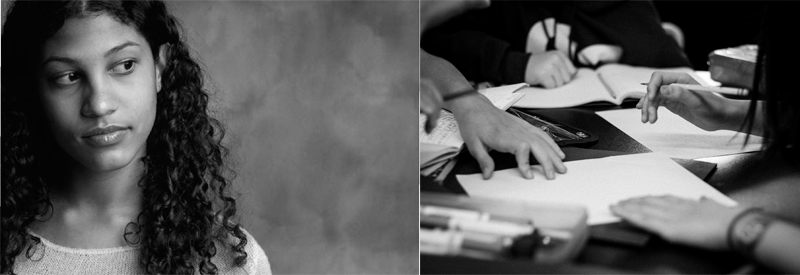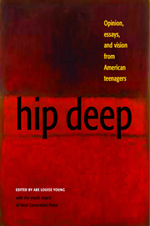
April 24, 2013
|
Note: We have a limited number of print copies still available, for sale. For multiple copies at discount, please write info@nextgenertionpress.org. |
SEE ALSO Making Writing Essential to Teen Lives (PDF) Cultural Conversations through Creative Writing (PDF)
|
PROVIDENCE, RI —Under the new Common Core State Standards (CCSS), by the last couple years of high school, about 70 percent of what students read across all subjects must be nonfiction. And narrative writing is one of the three types of texts and purposes specified by CCSS in relation to student writing in grades 9 - 12.
According to the secondary English Languge Arts standards, students must be able to write narratives to develop real or imagined experiences or events using effective technique, well-chosen details, and well-structured event sequences. They must be able to produce clear and coherent writing in which the development, organization, and style are appropriate to task, purpose, and audience. Students must be able to develop and strengthen writing as needed by planning, revising, editing, rewriting, or trying a new approach. They must be able to use technology, including the Internet, to produce and publish writing and to interact and collaborate with others.
For WKCD, this emphasis on narrative writing—and publication—has great resonance.
Seven years ago we asked: How do you get teenagers to read and write as if their lives depend on it? How do we draw in students for whom literacy has regularly spelled failure and poor test scores have sapped their spirit?
For adolescent learners, we decided, the answer lies in the chance to use language critically, seeing it not as a barrier but an entry into a world they can question and shape. They will start reading and writing when it taps their desire to take hold of their world, explore their identity, be taken seriously, and have their voices carry.
With this in mind, we spent a year gathering remarkable personal narratives from more than fifty young writers—from villages in Alaska to housing projects in Alabam—and created our popular anthology Hip Deep: Opinion, Vision, and Essays by American Teenagers. We longed to produce a book that combined the adrenalin of fresh viewpoints with eye-opening stories about the diverse conditions of teenagers’ lives. Equally, we wanted to create a showcase for nonfiction writing by adolescents for adolescents, hoping to inspire students and teachers to embrace on their own the power of the personal narrative.
Though seven years old, the essays in Hip Deep still stir young readers, we're told. William Harvey describes playing his violin for soldiers digging through Ground Zero. Eric Green writes a moving account of struggling to succeed in high school despite his fetal alcohol syndrome. Telvi Alitimirano, a fifteen-year-old Latina from Texas, contributes a sassy manifesto about her choice to remain a virgin, standing her ground with style against “all those little boys who try to hit me up.” Matan Prilletinsky gives a scathing analysis of the juvenile death penalty. Juliana Partridge examines her biracial identity: “I am the taste of daybreak, the initiator of a new world.”
Other writers take on international politics, gay marriage, divorce, religious and cultural freedom, poverty, sports, and many other subjects. The young editors of Hip Deep culled essays, poems, speeches, and radio journals from the most distinctive work by people under age 19, first published in print, on websites, or on airwaves in America. More often than not, the authors whose work they selected represented youth traditionally marginalized by race, class, and language.
Urging teachers to bring it into their classrooms, Dixie Goswami, who directs the Bread Loaf Teacher Network at Middlebury College, wrote in her preface: “Hip Deep provides us with ways of understanding what literacy means. Here, young people experience writing as a source of satisfaction, as well as a way to discover who they are and who we are, as readers.”
Poet Naomi Shihab Nye called Hip Deep “a collection to wipe the sorrowful spin of news from our eyes and ears, to remind us there is truth out there somewhere, and it’s young as well as timeless, and it feels wonderful to find it. This is a book for every teacher, every high school, every parent, and every person in this land who cares about the intriguing, necessary stories of young lives.”
Here we offer a PDF of Hip Deep: Opinion, Vision, and Essays by American Teenagers (Next Generation Press, 2006). Included, too, are guides to making writing essential to teen lives by WKCD consultant Abe Louise Young, a poet and writer in Austin, Texas.




